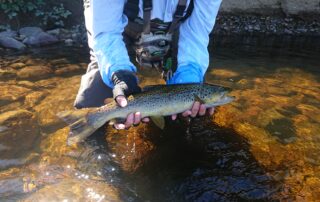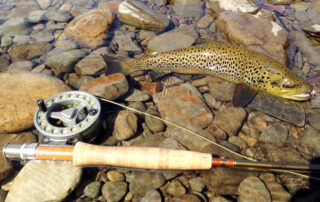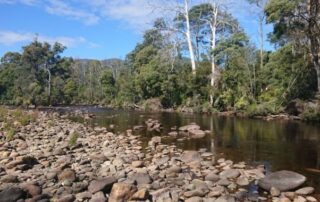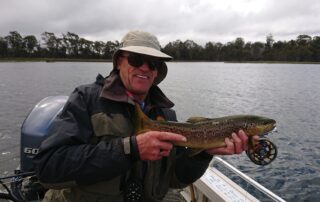Leven River, Tasmania
The upper reaches of the River Leven, not far from Cradle Mountain, rise through sink holes just like the Vale River and they are both on opposite sides of the range. The water of the Leven is very light tannin, and the Leven is one of the only rivers in Tasmania with no dams on it. It also has the highest values for macro invertebrate counts. There are good numbers of Mayfly and this is used as a scientific indicator to show the quality of a river system. There is Anglers Access at Loongana, a section which is open from [...]
Mersey River Tasmania
MERSEY RIVER The Mersey River is a very clear-water stream, has a long journey from the mountains to the sea, and is well served with Anglers Access information and infrastructure. There are bright open sections with plenty of shaded areas, fast water runs and riffles, as well as extended flat pools. On bright sunny days, late season, Mersey trout can be found sipping small mayfly from the surface. Felt soles are ideal on the rocky river sub-straight for good grip and a silent approach. Oxley Falls, above Lake Rowallan, which is open until the end of May. The fish [...]
River Leven Tasmania
River Leven TasmaniaThe River Leven is a wild trout fishery in Tasmania's north west. A bubbly, boisterous river, it is long, with much of it in deep forest and gorge terrain. A river of classic runs, riffles, glides, and pools etc. The head waters start not far from Cradle Mountain and enters the sea at Ulverstone.Great trout fishing can be found on the River Leven late season, boasting beautiful coloured wild browns a month or so away from spawning. Cool water temperatures, clean tannin water, and the fish still willing to take dry flies.It's a diverse fishery, and this is [...]
South Esk River Tasmania
SOUTH ESK RIVER The South Esk River is Tasmania's longest river, rising to the east of Ben Lomond and flowing east then south to Fingal where it then turns to the south west and follows the Esk Main Road toward Conara, then turns North West where the Macquarie River flows into it at Longford, flowing on through Hadspen to the Trevallyn Dam in Launceston, the final leg courses through the Cataract Gorge into the Tamar River estuary. We love the South Esk, there are so many great access points to generally clear water, many tributaries joining it along the [...]
Nineteen Lagoons Tasmania
NINETEEN LAGOONS - Gateway to the Western Lakes Wilderness Consisting of a network of lagoons, each with its own individual characteristics, some isolated, others connected via creek systems, these waters are within an easy reach of the highland accommodation base at Miena in the Central Highlands and are a fly fishing paradise. The lagoons surround Lake Augusta and provide a taste for the more remote section of Tasmania's enchanting fishery. A gateway to the Western Lakes, the lagoons have a varied food supply, due to their individual geography; some are rocky, some are shallow, some deep, others with sandy bottoms, [...]
Meander River Tasmania
MEANDER RIVER The Meander River, in northern Tasmania, is approximately 45 minutes drive from Launceston. A clear, boulder strewn fast water, the Meander is a tail race water from the Huntsman Dam, which has a good regulated environmental flow. It's a clear, fast water, with some deep holes and slow sections, with both brown and rainbow trout. ANGLERS ACCESS The Inland Fisheries Service also provides useful information about many Tasmanian trout waters, including access points, anglers notes, and maps. Brochures are available at most fishing stores, visitor centres, or online. See the Anglers Access for Meander River. See here for full [...]
Macquarie River Tasmania
MACQUARIE RIVER. Mayfly meadow trout stream Classic mayfly fishing. The Macquarie River is a low-lying meadow river through most of its reaches and flows in one of the flattest areas of the northern midlands. Renowned for its flood fishing mainly in the spring, the rains force the flow over the banks and into the hollows, divots, ditches, swamps and marshes. The result is tailing trout after worms, slugs, snails and the like. Sometimes there is good terrestrial food available in these floods and trout rise freely to the spiders, beetles and hoppers, providing exciting fly fishing. At times a [...]
Little Pine Lagoon Tasmania
LITTLE PINE LAGOON. FLY FISHING ONLY TROUT WATER On the Central Plateau, Little Pine lagoon is a fly fishing only trout water, shallow and well suited for wading. With grassy shorelines, marshes and excellent weed growth, it is surrounded by tussocks and heathland. Tailing trout are a highlight early season. I personally like to put on a small dry beetle, such as a red tag, to tailing fish, and when they are on the cruise, showing both tail and dorsal, they are usually obliging. When the trout are being difficult, persistently fishing a suspended nymph will often do the [...]
Penstock Lagoon Tasmania
Penstock Lagoon The jewel of the Highlands, Penstock Lagoon is a 'fly fishing only' lagoon surrounded by trees. A clear water lagoon, Penstock is shallow - around 4 feet, around 3km long and averages around 800 meters wide. Penstock is almost entirely covered with rich week growth and abundant, aquatic macro invertebrates. Early season trout menu includes snails, shrimp, scud, damsel fly, mudeye, or dragonfly larvae. Around October we see the first Mayfly hatches, followed by brown dun, red spinner, nymph, mayfly nymph, gum beetle falls, jassids/leaf hoppers, chironomid, caenid... the list goes on there's so much [...]
Arthurs Lake Tasmania
Arthurs Lake Tasmania Located in Tasmania's Central Highlands, Arthurs Lake is around 45 minutes from Cressy in to the Jonah Bay boat ramp, which gives access to the Cowpaddock and beyond, and most of the northern end of the lake. Arthurs Lake is a consistent, viable, sustainable fishery, and the most popular, most productive trout lake in Tasmania. Midge hatches, Mayfly, and beetle falls are some of the most common occurrences on Arthurs. As well as this, it boasts a huge aquatic food bowl, with snails, shrimp, scud, and Jassid. Arthurs Lake is a premier wild brown trout fishery [...]




